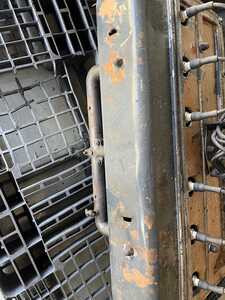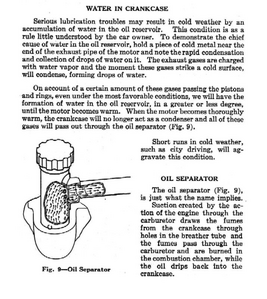Guys I have 2 1929 valve covers. Both have 2 holes that look like they were cut into the top as breathers. They don’t look factory. I know my 236 had slits in the cover which I sealed up and added a breather to keep the engine a little cleaner.
Are these holes needed? Can I close them up and add a breather?
se attached pic.
On the engine pictured, the holes are not needed.
That engine was meant to ventilate through the gaps around the spark plugs in the side cover.
Those holes NEED to be closed up as they will be letting dirt, sand, and everything smaller than a rock into the engine. 🙂
I believe late 1929's, and certainly 1930's and after had the gaps around the spark plugs closed up and narrow slots stamped into the valve cover.
Those slots however were narrow, faced the rear of the engine, and were semi-protected by a lip over them to at least help somewhat to keep "stuff" out of the engine.
PS
The 216 in my '46 has 3 slots in the valve cover, which I lightly stuff with felt to act as breather filters.
However, I have been considering installing a later valve cover with the holes closed as you have done and the hole for the filler/breather cap already in it.
Ole S Olson
Saskatoon, Sask, Canada
1946 DR 3/4 ton stake
1139 old site posts
@ole-olson Thanks Ole, I figured they were not a good idea. I have a valve cover from my 1953 216 that has a filler cap and no slots or holes. I think I will replace this one with that and install a breather.
My 31valve cover has 2 slots cut in it. I believe that they are there to relieve any pressure that may develop. If there is no way for that pressure to go, it will probably leak at the gasket. Your thought of putting a breather cap would elevate any pressures.
Hello,
Like 60340 says, my 31 valve cover has 2 aero-dynamic aft facing slots for pressure relief. Mini air breathers for engines won't elevate internal pressure. Look for them on internet. You might be able to salvage your valve cover.
@harry-truppner my 31s have those too but the covers are much taller and one of them is junk. Lots of tiny pinholes in it. I closed up the holes in mine I will look for the mini breathers. Thanks
The slots weren't to relieve pressure.
They were there as air INLETS.
The vacuum created at the outlet of the road tube, which was part of the assembly where oil was poured into the engine, pulled air in through those slots, down through the engine, and out under the car.
The lips over the slots were there to exclude as much "stuff" as possible from the incoming air. 🙂
PS
I should add that on '29s, air was drawn in around the spark plugs through the side cover.
That air, with crankcase fumes, was pulled out of the crankcase through the oil filler, through a tube and into the air taken into the carburetor at the "air cleaner" (or what passed as an air cleaner in 1929).
An early PCV system if you will.
Ole S Olson
Saskatoon, Sask, Canada
1946 DR 3/4 ton stake
1139 old site posts
Just to add to the conversation, please look up on google "why are there vents in a valve cover".
With due respect... I never take google's AI overview seriously, as it is sometimes demonstrably wrong.
Never the less, some engines do vent out through valve covers.
However, 6 cylinder Chevrolets without later PCV systems never ever did.
The tube connecting the oil filler tube to the carburetor inlet on the 1929's and '30s, and the road tube after that, completely precludes the possibility of pressure building up in the crankcase or any other part of the engine as long as the road tube hasn't become plugged due to neglect.
Late in '55, Chev figured out that it might be a good idea to actually filter the air ENTERING the valve cover, so they got rid of the slots and put a cap with an oiled mesh in the filler hole... which had been in the valve cover since 1949 but was capped with a solid cover to that point.
Below is a short excerpt from the 1930 owners manual showing where and how gases and pressure were removed from the interior of the engine at that time.
Implicit in the above excerpt is that due to the vacuum created at the oil separator, air will be drawn into the engine through the side cover openings around the spark plugs in 1929, and the slots in the valve cover thereafter.
Ole S Olson
Saskatoon, Sask, Canada
1946 DR 3/4 ton stake
1139 old site posts
Hello Stovblt,
Thank You for the description about the slits in the valve cover being for inlet air. It makes sense and I don't recall seeing any oily deposits around those slits either.




